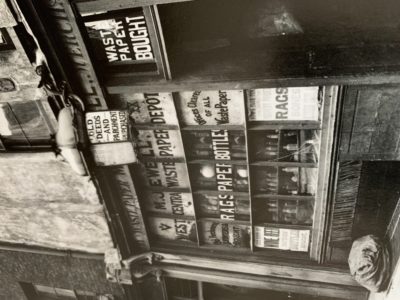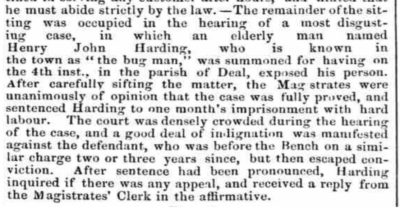Follow us on Facebook @FHofDW
Henry John Harding
1 York Street, Shoreditch/Bethnal Green
131 & 171 Lower Street, Deal
Northwall, Deal
48 Middle Street, Deal
10 West Street, Deal
Occupation: Waste Paper Dealer, Bookseller, Taxidermist, Gardener
Henry Harding was born in Stepney, Mile End, London on June 5th 1804. His parents were Pearman, son of a hat maker, and Elizabeth Harding. Henry was baptised in St Dunstan’s and All Saints, Stepney on July 8th 1804. On his baptism record it states that his father was a Silk Weaver.
It appears that Henry and his family lived in the same house in Church Street, later to become York Street, Bethnal Green, for some considerable time.
This area of London was well known for its Silk Weavers. Highly skilled workers, many of them descended from The Huguenots who emigrated from France to escape religious persecution after the Revocation of the Edict of Nantes in 1685. Around 50,000 Huguenots came to England with many settling in London. Others went further afield to Canterbury, Faversham and Sandwich.
One area in which Huguenots were particularly skilled and industrious was silk weaving and the 1841 census tells us that Pearman, Henry’s father and also his siste, Elizabeth Mary, were both Silk Weavers. Henry at this time was assisting his mother, Elizabeth with her book and stationery business a trade in which he continued.
By 1835 Henry is a Waste Paper Dealer. Dealing in this commodity was an occupation to be found throughout the country but especially in the big cities such as London. Clean thin paper would be sold to cheese mongers, butchers, ham, pork and oil shops and general dealers. If the paper was a little soiled on one side it would be purchased by ironmongers for wrapping candles, soap and soda. Fishmongers required stout paper and unused paper from large ledgers used by accountants was sold on to Tobacconists and Goldbeaters.
In June 1853 Henry John is a witness in a case tried at the Old Bailey. It concerned Simple Larceny. Two men were being tried for stealing 112lbs of waste paper and selling it on.
It seems Harding kept hundredweights of waste paper in the cellar of his house in York Street. During the trial he explains to the jury that there is both good waste paper and bad waste paper, high priced and low priced. It could not be used for anything other than waste paper – it is mostly misprinted. He says he frequently bought books, with torn off covers and sold them on as waste paper. Here we speculated that Henry might have been selling the books as part of his mother’s business and not for re-cycling at all!
Harding bought printed paper, prints and publications from the Printers, Cassells. They were well known for printing the Illustrated Magazine of Art. The accused, Hogan, was employed to enter their offices, early in the morning, sweep the floors and empty cupboards where waste paper had been left for him. He would gather it all up in sacks and take it away leaving the office clean for the day to start. On this occasion it seems he took more than just ‘waste paper’ as Hogan was followed by the police one night and caught selling to Harding unpublished prints of artwork, ‘Madonna and Child’, destined for Cassells’ Art Magazine. We are not quite sure how Harding managed to wriggle out of being an ‘accessory’ during this trial but he was only a witness and not charged.
We have been unable to trace Henry in the 1861 census but by 1862, the Kelly’s Directory for Kent tells us that Harding has left Bethnal Green and transferred his Bookshop and Taxidermy business to 171, Lower Street, Deal. We presume his non appearance in the 1861 census is due to him being in transet from London to Deal and was simply missed by the ennumerator.
In the 1871 census the York Street house in Bethnal Green is empty and as we have been unable to trace a definite death for Henry’s mother and sister it does seem likely they both died leaving Henry free to move away from London and re-locate his business elsewhere.
From Kelly’s Directory of 1874 we know that Henry moved from 131 Lower Street to 171 Lower Street where he continues to run his business as a Bookseller and Taxidermist. But why Deal? We don’t know for certain why Henry decided to locate to this area but the bracing sea air might have had something to do with it. In 1855 the human waste of some 2.5 million Londoners was either left in the ground or put in to the Thames. A ‘Table Mountain of manure’ at Digby Street, Bethnall Green, sat beside extensive and deep lakes of putrefying night soil. Not a pleasant area to be living in!
Henry Harding came to our notice as we were completing some research using the British Newspaper Archive site. This report made us want to know more about why someone was known, locally, as ‘The Bug Man’. The reason for his nickname is that the books he sold were all about the natural world as was his obvious skill in the art of taxidermy – the preparing, stuffing and mounting the skins of animals. The Spitalfields and Bethnal Green silk weavers were fabled for their intellectual vivacity. They had a passion for caged birds and were well known for their mathematical, botanical and microscopical societies. If Henry had been exposed to these societies throughout his young life it is not surprising he became knowledgeable on the subject of nature. Enough, at least, to have earnt him the moniker of ‘The Bug Man’.
Unfortunately, being the ‘Bug Man’ wasn’t the only thing that Henry became known for in the town of Deal. The newspaper report we found was written in 1869 and showed that Harding did not have a good reputation amongst the townsfolk. His crime was described as of a ‘disgusting nature’ when he was called before the magistrates for the second time for exposing himself in public. He was sent to prison for one month despite asking if he could appeal. As this was a repeat offence his plea fell on deaf ears!
Then in 1876 Henry makes the papers again, this time though he is accusing one John Ladd of assaulting him!
By 1881 Henry is sharing a house at 10 West Street, with a young married couple. He had by then moved several more times. Seemingly, this house was split in to two residences. He was no longer running his bookshop and taxidermy business and now gives his occupation as a gardener.
Henry John Harding died in 1884 in Eastry Union Workhouse, aged 80. His death certificate states he was a ‘Naturalist of Deal’ and that he died of ‘old age’ on the 29th October. He was buried a few days later on 1st November in Hamilton Road Cemetery.



